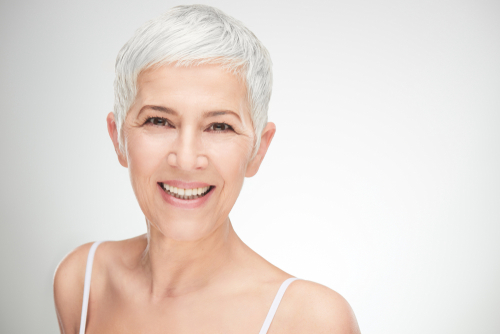
Facial fat transfer, also called autologous fat grafting or fat injections, is a type of natural soft tissue filler. It’s an excellent way to address facial deflation, one of the three D’s of aging: descent, deflation, and deterioration. Fat can be used in virtually all areas of the face, including the lower eyelids, eyebrows, lips, cheeks, and nasolabial folds (the smile lines that run from each side of the nose to the corners of the mouth). It helps restore a youthful appearance, enhance the lips, and fill in the creases that deepen with age.
Fat transfer has been used for decades, and techniques continue to advance. One of the most promising developments is Adipose Derived Stem Cell Fat Transfer. This technique involves isolating adult stem cells from your harvested fat and then reinjecting them into the desired areas. Using stem cells in this way has improved the survival of the fat and the success rate of the procedure.
At Mitchell Plastic Surgery, facial fat transfer is performed by Dr. Ryan Mitchell, a Board-Certified Facial Plastic Surgeon with more than 20 years of experience in aesthetic and reconstructive surgery. Recognized throughout the Las Vegas and Henderson area for his skillful approach to facial procedures, Dr. Mitchell applies advanced fat grafting techniques with a focus on safety, artistry, and long-term outcomes.
What Is Autologous Fat Transfer?
Autologous fat transfer is the process of harvesting fat from your own body and transferring it to a new area, typically the face. The harvesting method is similar to a small liposuction procedure. A thin cannula is inserted into a chosen donor site, and fat is drawn out manually using syringes. This is gentler than traditional liposuction, which uses mechanical suction.
Why Is Fat Transfer Performed?
Fat transfer is used to reduce wrinkles and restore volume lost due to aging. As discussed throughout this website, deflation is a major factor in facial aging. While some people naturally have more or less facial fat, everyone loses volume with age. That’s why full cheeks are rare in older adults.
Fat transfer offers an option for facial rejuvenation using your body’s own tissue. While synthetic fillers, such as Juvederm, Radiesse, or Artefill, are commonly used for volume restoration, some patients prefer fat grafting. This is often due to the availability of their fat, the potential for longer-lasting results, and the desire to avoid synthetic materials.
Commercially prepared fillers may be chosen by non-surgical aesthetic providers due to their ease of use and minimal downtime. Still, fat grafting offers unique advantages for suitable candidates.
Common Areas for Facial Fat Transfer
Fat transfer is a highly versatile treatment that can enhance nearly every region of the face. While the cheeks and nasolabial folds are the most commonly treated areas, many patients also benefit from volume restoration in other zones.
Popular treatment areas include:
- Lips: to restore fullness and shape or correct age-related thinning
- Brow and Forehead: to soften hollows and lift the upper face
- Lower Eyelids: to improve under-eye hollows and reduce a tired appearance
- Jawline and Chin: to enhance definition and balance facial proportions

By strategically placing fat in one or more of these areas, the procedure can create smoother, more youthful contours tailored to each patient’s features.
What Is Autologous Fat Stem Cell Transplantation?
Autologous fat transfer, which includes stem cell enrichment, is an exciting step forward in cosmetic treatment. Adult stem cells found in fat—especially around the abdomen—can help support the success of the transfer.
These cells are multipurpose and support the natural repair and renewal of tissue. Unlike embryonic stem cells, adult stem cells taken from your fat carry no ethical concerns and can adapt to the tissue they’re placed in.
When these stem cells are added to transferred fat, they help create new blood vessels and support long-term fat survival. They may also differentiate into fat or skin cells, thereby improving the quality of the treated area. Patients often notice an improvement in skin texture, reduced wrinkles, better coloration, and even smaller pores.
The fat is processed by a medical lab directly after it’s harvested. Using enzymes, the fat is partially digested to release the stem cells, which are then cleaned, filtered, and recombined with your fat. This produces a mixture that can contain hundreds of thousands of viable stem cells per cc. This enrichment supports better volume retention and may reduce the number of sessions needed.
Fat Transfer vs. Injectable Fillers
Both options aim to restore volume, but there are important differences:
- Fat transfer uses your own tissue. Fillers are synthetic.
- Fat is harvested and reinjected, requiring more time and mild recovery. Fillers are preloaded and injected in minutes.
- Fat is often more cost-effective in the long term, especially for larger volume needs.
- Fillers are sold by the cc (one-fifth of a teaspoon), which may not be enough for significant volume loss. With fat transfer, you have access to a larger quantity of material.
Both are performed with local anesthesia. Fat transfer can be combined with sedation or general anesthesia if needed. Fillers typically require no downtime. Fat transfer patients may need two or more recovery days, depending on the areas treated and the volume used.
What to Expect After Surgery
You’ll receive complete recovery instructions before your procedure. If sedation is used, you may feel sleepy for the rest of the day. Most patients experience mild to moderate discomfort, which is typically managed with prescription medication.
Some swelling and bruising are normal for the first week. This depends on the amount of fat transferred and its location. For larger cases, a soft diet is recommended for the first day or two. Most patients resume a regular diet the next day.
Cool compresses may help reduce swelling in the first 48 hours but never apply ice directly to your skin. Local anesthesia can numb the skin, which increases the risk of frostbite if ice is applied improperly.
You can shower the next day. Shampoo and other personal products are usually fine. Antibiotics and pain medications will be provided as needed. Elevating the head while sleeping will help reduce swelling and bruising.
Frequently Asked Questions
Most healthy adults with realistic expectations may be candidates for facial fat grafting. The procedure is ideal for people who want fuller cheeks, plumper lips, or more overall volume in the face. Adults over 40 often show visible signs of aging that can be addressed with fat transfer.
If the procedure is performed carefully, fat transfer can offer long-lasting or even permanent correction of facial hollows and deeper wrinkles. Standard fat transfer may see around 40% fat survival, meaning multiple sessions could be needed.
Stem cell-enriched fat increases the survival rate. Patients who choose this method may reach their desired outcome with only one or two treatments, compared to three or four using standard fat.
Most facial fat transfer procedures are done in the office under local anesthesia. For larger cases or patients who prefer sedation, the procedure may take place in an accredited outpatient surgical center.
Fat is removed using a process similar to liposuction. The donor site is selected with the patient and numbed using diluted local anesthesia. Using small cannulas, fat is drawn into syringes and collected gently to preserve the integrity of the fat cells.
The harvesting method is designed not to leave noticeable dents or irregularities. In many cases, the donor site actually appears more contoured after healing.
Once the fat is processed, it is carefully reinjected into the planned facial areas. Preoperative markings and photographs are used to guide the process. The cannulas used for fat reinjection are slightly wider than filler needles but are still comfortable with local anesthesia.
The fat is placed in small, even amounts at multiple depths to help the graft survive and blend naturally with your existing tissue. Sedation or general anesthesia is available if preferred.
Fat transfer can take anywhere from 45 minutes to three hours, depending on the number of areas treated and whether stem cell processing is used. Stem cell enrichment adds about 45 minutes while the fat is processed and prepared.
As with all surgical procedures, risks include infection, bleeding, scarring, and temporary changes in sensation. Motor nerve issues are rare and typically resolve quickly. Under- or over-correction may require additional sessions.
Most patients recover well and are satisfied with their outcome, especially when realistic expectations are set.
Why Choose Mitchell Plastic Surgery
Dr. Ryan Mitchell brings over 20 years of focused experience in facial aesthetics to every fat transfer procedure. As a Board-Certified Facial Plastic Surgeon and Fellow of the American Academy of Cosmetic Surgery, he combines expert surgical training with a deep understanding of facial harmony and aging. Patients trust him not only for his credentials but also for his warm, patient-centered approach. He completed his residency in Otolaryngology and Facial Plastic Surgery at Pontiac Osteopathic Hospital and serves as Clinical Faculty at Touro University, where he helps train the next generation of physicians.
Dr. Mitchell’s goal is to create natural-looking, long-lasting results using advanced fat grafting techniques. His meticulous attention to detail and dedication to natural outcomes have made him a trusted choice for facial rejuvenation throughout Henderson and the Las Vegas Valley.
Restoring Facial Volume Naturally in Henderson, NV
Facial fat transfer is a natural, long-lasting way to restore volume, smooth wrinkles, and refresh your appearance using your body’s resources. Whether you’re just starting to explore options or looking for an alternative to synthetic fillers, our team is here to guide you every step of the way. Contact us at 702-376-3095 to schedule your consultation with Dr. Mitchell today.
Sorry, we couldn't find any posts. Please try a different search.
Testimonials
What People are Saying
Dr. Mitchell's patients love him and his team and are always incredibly happy with their results!
A skilled personable artist with integrity. I had Radiesse done on a few occassions with Dr. Mitchell with great results. He will recommend what he thinks will help the patient ...
Excellent doctor! Had Blepharoplasty done and he did an amazing job!! Perfect work. He is also very kind and takes his time to listen to your needs. He is also ...
Recently had liposuction done by Dr. Mitchell on a problem area in my mid section and I couldn't be more happy. The staff was great and the results are amazing. ...